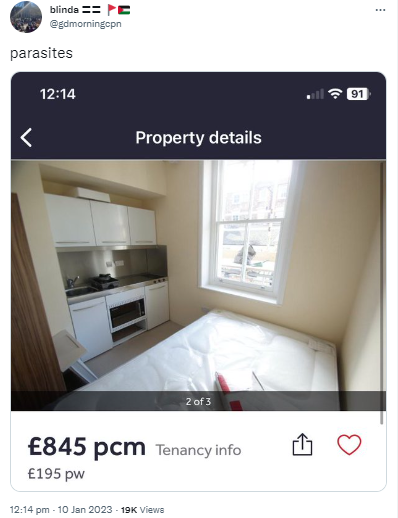Will rents continue to rise?
Image shows a screenshot of a rental advert for a room in London costing £845 per month. It seems to be a box room, with the bed directly next to kitchen facilities and a small window. Posted by Twitter user @goodmorningcpn.
By the Summer of 2022, rents in London had hit a record annual growth of 15.8% and by September, they reached new heights across the country, with a huge surge in London as the average rent tipped above £2,000 a month for the first time ever.
By December, Zoopla were reporting “a stinging swathe of rent rises” across the country with London rents soaring by 17% or £273 a month.
Forecasts for 2023 expect rent rises to continue. The reason is the growing gap between supply and demand, as the number of private rented homes has been decreasing at the same time that demand has risen because people cannot afford to buy. The shortfall of private rented homes is estimated to be 30%. The private rented sector is no longer dominated by younger people as alternative housing options cease to exist – over 50% of renters are now aged 45 or over.
With mortgage interest set to rise further, we can’t expect to see a drop in demand from renters, so will these astronomical rents attract more landlords to invest in renting? The cost-of-living crisis looks set to continue for at least the next year, and fuel bills are rising even more steeply than rents, creating a double whammy for renters whose homes are the most energy inefficient. With increasing numbers of renters forced to default on the rent, and possession claims rising steeply, it doesn’t look like a particularly attractive scene for either landlords or tenants.
Surely the sensible answer has to be a massive, yes really massive, increase in social rented homes. Because the affordability crisis is with us now and new homes take months or years to build, the Government should be doing everything it can to enable local authorities to supplement new, energy efficient homes with buying existing properties, retrofitting them, and letting them at social rents. This would address the affordability problem for renters on lower incomes and relieve the current pressure on the private rented sector.

